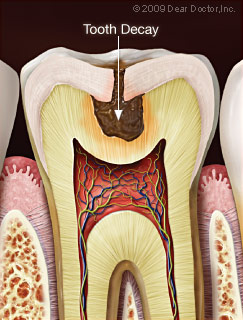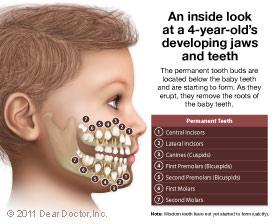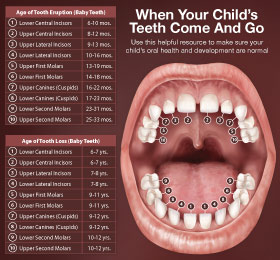Dentistry & Oral Health For Children
Guiding your child's oral health from birth through adolescence
(Continued)

A New Slant On An Old Disease — Tooth Decay
Why do some children and adults get tooth decay and others don't? Tooth decay, believe it or not, is an infectious disease and best understood by picturing it as a balance between pathogenic (disease causing) and protective (health promoting) factors. Each individual has his/her own balance. BAD Pathogenic factors include Bad bacteria, the Absence of healthy saliva (and its ability to neutralize acid), and poor Dietary habits. SAFE Protective factors include healthy Salivary function and Sealants (to seal the areas most likely to decay), the use of Antibacterial agents, topical Fluoride, and a healthy Effective diet.
Today many dentists use a system known as Caries Management By Risk Assessment (CAMBRA) to help figure out an individual's risk for developing this disease. There are special and separate assessments for the newborn-to-6-year-olds and for adults, catering to the needs of these groupings, and those in transition.
Transitions
Shedding the vestiges of childhood is like shedding leaves from a tree. One may argue that nothing typifies growth and change better than losing deciduous (baby) teeth, but did you know that the deciduous teeth actually begin their development at about the sixth week of life in the womb, and the permanent teeth begin to develop while the baby teeth are in use? As the jaws grow, the crowns of the new teeth actually push against the roots of the baby teeth, causing them to resorb, or melt away, so that the adult (permanent) teeth can take their place.
 |
| Click to enlarge |
 |
| Click to enlarge |
Often referred to initially as the “ugly duckling” phase, with teeth seemingly going in every direction and space, this is accompanied by tremendous physical and emotional changes. Hormones are raging, acne is exploding, and more. But as the storms finally cease, your baby emerges as a young (almost) fully fledged adult — cygnet to ugly duckling, to swan!
As jaw growth occurs in concert with the emergence of adult teeth, malocclusion (“mal” – bad; “occlusion” – bite) can become evident, or if already present it can get worse. Early detection of orthodontic problems (“ortho” – straight; “dont” – tooth), even as young as 7 years old (as you will note in our Nolan Gould interview), may reveal the need for early or interceptive orthodontic treatment. This can help direct proper jaw growth, eliminating or simplifying the need for later treatment.
The options for orthodontic treatment today for teens have improved as dramatically as the results they can achieve. Clear aligner technology — custom-made computer-generated “trays” that fit over the teeth precisely, with each tray varying incrementally from its predecessor — ultimately result in a new and functional smile. Today this can prevent the need for traditional braces, the ones that look like mini train tracks, through which special “arch” wires are threaded. As the wires unravel, they leave the teeth in an ideal new position. Which method is right for your teen? This will depend upon your child's diagnosis and malocclusion, and the skills and experience of the orthodontist, or dentist with additional training in orthodontic techniques. Read more in our article on clear aligners for teens.




